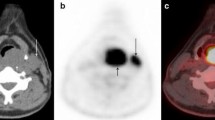Abstract.
The aims of this study were to investigate the detection of cervical lymph node metastases of head and neck cancer by positron emission tomographic (PET) imaging with fluorine-18 fluorodeoxyglucose (FDG) and to perform a prospective comparison with computed tomography (CT), magnetic resonance imaging (MRI), sonographic and histopathological findings. Sixty patients with histologically proven squamous cell carcinoma were studied by PET imaging before surgery. Preoperative endoscopy (including biopsy), CT, MRI and sonography of the cervical region were performed in all patients within 2 weeks preceding 18F-FDG whole-body PET. FDG PET images were analysed visually and quantitatively for objective assessment of regional tracer uptake. Histopathology of the resected neck specimens revealed a total of 1284 lymph nodes, 117 of which showed metastatic involvement. Based on histopathological findings, FDG PET correctly identified lymph node metastases with a sensitivity of 90% and a specificity of 94% (P<10–6). CT and MRI visualized histologically proven lymph node metastases with a sensitivity of 82% (specificity 85%) and 80% (specificity 79%), respectively (P<10–6). Sonography revealed a sensitivity of 72% (P<10–6). The comparison of 18F-FDG PET with conventional imaging modalities demonstrated statistically significant correlations (PET vs CT, P = 0.017; PET vs MRI, P = 0.012; PET vs sonography, P = 0.0001). Quantitative analysis of FDG uptake in lymph node metastases using body weight-based standardized uptake values (SUVBW) showed no significant correlation between FDG uptake (3.7±2.0) and histological grading of tumour-involved lymph nodes (P = 0.9). Interestingly, benign lymph nodes had increased FDG uptake as a result of inflammatory reactions (SUVBW-range: 2–15.8). This prospective, histopathologically controlled study confirms FDG PET as the procedure with the highest sensitivity and specificity for detecting lymph node metastases of head and neck cancer and has become a routine method in our University Medical Center. Furthermore, the optimal diagnostic modality may be a fusion image showing the increased metabolism of the tumour and the anatomical localization.
Similar content being viewed by others
Author information
Authors and Affiliations
Additional information
Received 17 February and in revised form 12 June 1998
Rights and permissions
About this article
Cite this article
Adams, S., Baum, R., Stuckensen, T. et al. Prospective comparison of 18F-FDG PET with conventional imaging modalities (CT, MRI, US) in lymph node staging of head and neck cancer. Eur J Nucl Med 25, 1255–1260 (1998). https://doi.org/10.1007/s002590050293
Issue Date:
DOI: https://doi.org/10.1007/s002590050293




